Farmer Joe's dahlias.
- In brag, clients, female tattoo artist, flowers, hobo, tat zap wizard, Tattoo, travel, true stories,
Otherwise known as Bill the Butcher vs. Amsterdam



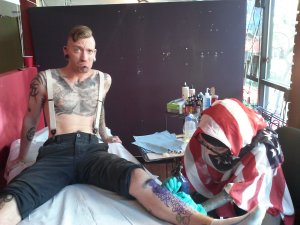
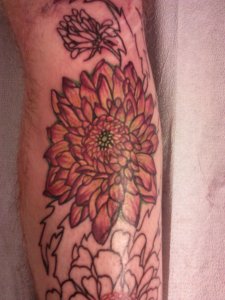
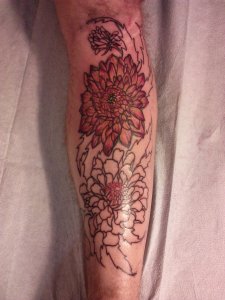


Te voy a enseñar a hablar Inglés con este cuchillo.
new prints and shirts ^^^
and some random stuff…vvv






new prints and shirts ^^^
and some random stuff…vvv






 Tattoos, just like a fur or a pair of old favorite boots, require some care to stand the test of time.
Tattoos, just like a fur or a pair of old favorite boots, require some care to stand the test of time.
Tattoos done before about 1990 have little hope of staying clear and unsullied by sun and weather and wear. The inks used before that time had many pigment ingredients which could react to sun exposure, and to the wearer’s own body fluids. These days, most tattoo inks used by professional artists are inert and hypo-allergenic, and at the very least should not react to the skin itself. They can still be faded and worn if not cared for properly. (Some people might still be allergic to certain inks, but it’s very rare.)
A tattoo is ink that is permanently set just under the translucent top layer of skin. This top layer is like an elastic window that you look through to see the ink. If the top layer is damaged or thickened or darkened, it becomes a dirty window. Age, sun exposure, and scars can all obscure a gorgeous tattoo and turn it into indecipherable mud. Also, the darker your skin, the more “tint” that window has.
When your artist gives you care instructions, follow them to the letter. Every artist uses different techniques to apply a
tattoo, and usually they know which healing procedure will work best in conjunction with it. Artists use such a variety of needle, ink, and bandaging material- as well as the variatons in YOUR body’s healing ability- that it’s impossible to give out one universal set of aftercare directions.
Don’t listen to your friends, other artists, or people you meet out and about. If you don’t trust the artist to know best, you should buy your tattoo from someone you DO trust. Pick an artist who you trust, and listen to them. They know how to help you heal your new work.
It’s OUR job to put the tattoo in just the right layer of your skin, just right. It’s YOUR job to do the other half- to heal your tattoo properly. Keep your tattoos clean while healing, and wash your hands before touching a fresh tattoo. Don’t wear tight things that will rub against or irritate your tattoo. Don’t swim or surf for the first few weeks. And most of all, let your tattoo get air.
A well-healed tattoo will make you happy for decades. Taking a few weeks to care for it properly is COMPLETELY worth it.
(written by me, originally published here)
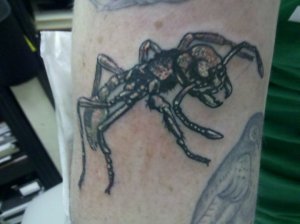 There are a lot of younger people today who are very interested in tattoos. In many cultures tattoos are used as a rite of passage from youth to adulthood, and in our Western culture it is no different. The lack of culturally-based rites of passage and tests of maturity leads many teenagers to seek alternate forms of self-challenge, and tattooing is currently high on that list.
There are a lot of younger people today who are very interested in tattoos. In many cultures tattoos are used as a rite of passage from youth to adulthood, and in our Western culture it is no different. The lack of culturally-based rites of passage and tests of maturity leads many teenagers to seek alternate forms of self-challenge, and tattooing is currently high on that list.
Children are only tattooed usually by indigenous or tribal groups to whom it is a cultural staple. Occasionally there will be a photograph of a child wearing airbrushed tattoos (which are painted on) in a magazine, but actual children are extremely rarely tattooed. If they are, it can be considered child abuse.
Although most jurisdictions outlaw the tattooing of minors, many children and teenagers will tattoo themselves at home, using sewing or other needles and common household dyes and inks. This can be extremely dangerous; using an unsterilized needle or one that has been used on another person can transmit disease or cause serious infections. Home-made tattoos tend to be deeper in the skin surface than professional tattoos, and this can lead to infections that cause excessive scarring.
Most commonly found dyes and inks in home use are not inert and can cause allergic reactions or other problems. Young people should NOT use household items to tattoo themselves; this is a given. That they WILL do it, is incontestable. Educating young people and explaining to them that sharing needles (no matter what sort of home “sterilization” they invent) can transmit HIV, hepatitis, and bacterial infections, is a good beginning; also it may help to explain that running a needle through flame, boiling it, or soaking it in alcohol or antibacterial wipes will not kill all bacteria or viruses that may be present.
 In addition, a home environment contains many bacteria and other germs that could infect a fresh tattoo. Lack of proper knowledge about cross-contamination and bloodborne pathogens can put kids at serious risk when they get tattooed in a home environment.
In addition, a home environment contains many bacteria and other germs that could infect a fresh tattoo. Lack of proper knowledge about cross-contamination and bloodborne pathogens can put kids at serious risk when they get tattooed in a home environment.
Since minors can not obtain a legal tattoo, they will often try to use fake ID to do so,and try going to a real studio instead of someone’s house. Usually shops can tell when they’re presented a fake ID, but a very well made one can occasionally slip through. Especially a real ID that belongs to someone who looks similar to the kid…
Parents should know that professional studios are not pleased about this; parents should always attempt to contact the studio where their child claims to have received a tattoo. Studios often are required by law to keep consent forms for up to two years, and can usually provide a copy of the false identification that was used. This is not negligence by the studio, but fraud by the minor. In some states the studio can prosecute the minor and their parent. Parents should make sure that their teenagers have no access to their wallets and purses.
When a teenager is nearing eighteen and the age of consent, parents should do research with them into studios they may frequent or patronize. It may be reassuring for parents to know that the studio is clean and reputable. Minors are often not welcome in tattoo studios without a parent; this can be a good opportunity for parents to ensure that if their teenager decides to get tattooed they are at least in a situation that is not unsafe or unhealthy.
Every professional tattoo shop should have an autoclave which is regularly spore tested, disposable latex or nitrile gloves should be used, and all workers there have proper health and safety training. Go with your kid, ask questions. We’re happy to explain all this stuff to you. We want all of our clients to be safe.
Bringing your teenager with you to investigate their options may also discourage them from performing unsafe tattoos on themselves at home, and may even dissuade them from getting a rebellion-motivated tattoo at all. After all, if parents approve, many teens won’t participate.
And if they decide to get one anyway, you will know where they’re going, and that they won’t be risking their health for it.
(originally published here)
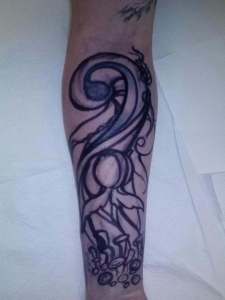
BEFORE, with marker drawing on top of old tattoo.

AFTER. old tattoo is no longer visible.
If only there was an eraser that worked on skin! All those past relationships and bad decisions would be so easy to forget.
Unfortunately, laser removal is the closest thing to the magic eraser, and it is expensive and painful.
Getting a coverup is a common solution. Here are a few easy things you can do to make sure you don’t make the same mistake twice-
Pretend you have no bad tattoo. Imagine a peaceful world in which that tattoo never even existed.
Now, picture a good tattoo on the area.
What does it look like?
Hint- it will NEVER be a current lover’s name, or the same as the old one, and it WILL be bigger than the bad tattoo.
Got it? Good. That’s your goal. Keep that image in your mind throughout these steps.
Things to keep in mind:

instead of covering up an old tattoo, sometimes you can repair it. If you like the subject of the tattoo but not the execution, this is a good option.
Find an artist. Look at every tattoo shop and website you can find. Shop around- at shops. Don’t go to someone’s basement or home to get tattooed. Look at professional artists only. It will cost some money, since coverups take longer to do, but it will be worth it to get rid of the old mistake. A professional artist who likes to do cover-ups or repairs will take the time to work with your already-existing work; they may send you to a laser removal specialist to get certain areas lightened (much cheaper than total removal), and they can make the old tattoo disappear under the new one.
Look at all the portfolios you can, and pick up a few tattoo magazines. Who is doing something that is similar to the style of your imaginary, new tattoo?
Try to find someone whose work resembles what you’re picturing as your new tattoo. Don’t look at the subject matter, look at the style. Look at the color choices, placement, and way of drawing.
If you like it, it is good. This is your personal art collection, and your taste is all that matters.
Talk to an artist. For coverups, you will most likely have to go in person to the studio and talk to the artist. Ask them if they enjoy doing cover-ups or repairs.
Getting a firsthand look at the problem is the only way to really plan a cover-up. Listen to what they have to say; take it into account. They cover up old tattoos often and will probably have some good advice for you about your particular situation. If they tell you something isn’t possible, listen to them. If they give you advice about ways to hide the older piece, pay attention.
Coverups must usually be much larger than the old tattoo. They also must have at least some areas of shadow to hide any pre-existing dark areas. Tattoo inks are translucent, and a paler color will eventually let a darker one underneath it show through. This does not mean your coverup has to be all black.
“Tribal” designs are actually a very poor choice for a coverup design, as they rely on areas of smoothly curving negative space to be attractive to the eye. The negative space is empty skin, and usually it takes a lot of work to coordinate this negative space in a design with what is already present.
You will not usually find a design ready-made to cover up your tattoo. Remember, it can come up through lighter colors. Your artist will have to draw something specifically designed to hide your previous work.
This may take time, so be patient. They may want to trace the area so they can use reference to draw on at home, or they may suggest freehand work.

cover-ups don’t have to be dark!
Freehand coverups done by good artists are the best solution to covering up an old unwanted tattoo. By drawing directly on the skin (drawing is done first with marker, then tattooed on) the artist can take into account the form of the old tattoo, as well as your anatomy.
The most important step in the entire process is finding the right artist. Look for someone you like, whose art you admire. Try to find an artist who enjoys not only coverups but also really appreciates the same kind of artwork that you do. Since all coverups are custom tattoos drawn by the tattoo artist, make sure the artist you pick has the same kind of taste you do.
Coverups can be very expensive. Tattoo artists know that if you had valued your personal canvas, and their artform, you wouldn’t need one! Be sure to tip well when getting a coverup done. Most artists spend more effort and time drawing for coverups than they would drawing an original tattoo, and most don’t charge anything for their drawing time. Be aware of this extra work they’ve done and tip accordingly.
You can’t get a coverup on the spur of the moment, unless it is so tiny that it’s hardly visible to begin with. You’ll have to plan in advance and think quite a bit about your new tattoo. Hasty decisions are the reason coverups exist in the first place, so take your time and do some research before you buy.
Getting a coverup may limit your choices in some ways, but the subject matter is still wide open. Knowing that it may have to be darker and larger should not keep you from getting a tattoo you can be proud of, and if you find the right artist you may even forget the old tattoo was there. If you have an idea of the subject matter you want, you can find a way to make it work, as long as you find someone who is capable of tackling the job.

this sea captain is actually a skilled tattoo artist
Never get someone else,
who is not a tattoo artist,
to draw a
tattoo for you
(especially if you are paying a non-tattoo artist for it).
This is why we do tattoos. Not only can we draw, we enjoy it. Also, we gain through our work experience a feel for the engineering of the surfaces of the human body; this is a quality of good tattooing that most other artists will not understand r use to its best advantage. (I.e.- where do you put the focal point on a sleeve? how do you draw perspective lines on a column that twists every time someone moves? how do you make mountains look distant on a round but mobile surface?) We also have an understanding of the formula of the medium. Time is not kind to the human body; when using it as a canvas there are a lot of pitfalls, and most non-tattoo artists fall into these constantly.
 I don’t care if you are getting a “cool” tattoo. I don’t care if you know the etiquette or not.
I don’t care if you are getting a “cool” tattoo. I don’t care if you know the etiquette or not.
All I care about is that you ask me the questions, I give you the answers, you know what you want and pay me to do it.
That’s my tattoo etiquette lesson. Just ask questions. I’ll answer them for you. I don’t mind, that’s the job.
I mean, if you smell, I might ask you to go home and wash up. If you argue about prices I might just tell you no thanks, find another artist. If I think the tattoo is a terrible idea I will just tell you that, and try to suggest ways to make it a better idea. If you start talking like you know a lot about tattooing, I might laugh at you a little. That’s it.
The only thing that really bugs me at work is people arguing about price. Tattoos aren’t groceries or brain surgery, you will not die without one. I can’t lose money just to tattoo you. The prices are pretty standard, you’re not paying much more or less than you would in any decent shop.
Other than that, there’s pretty much nothing you can do to phase me. I know a lot of people get nervous coming to the tattoo shop, and I know a lot of people get weird or awkward when they get nervous. So it’s ok if you feel nervous or have lots of questions. If you can’t get a sitter to leave your kids at home, just wait until another day. If you need more time to save up money, just let me know. If you have a budget just say so- I’m used to drawing things to the right size or level of detail to try to stay within budget. If you’re worried about pain, let me know so I can talk you down.
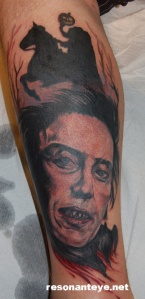 I’m not a nurse or very good at babying people, but I’m willing to talk you through all the things you’re not sure about. I mean, I do have hard days or bad days. Of course, I’m human. But my worst day as a tattoo artist? Is better than my best day ever, before I was one. So I’m not going to freak out on you. I love my job and you are the job. You know?
I’m not a nurse or very good at babying people, but I’m willing to talk you through all the things you’re not sure about. I mean, I do have hard days or bad days. Of course, I’m human. But my worst day as a tattoo artist? Is better than my best day ever, before I was one. So I’m not going to freak out on you. I love my job and you are the job. You know?
.
(“walken from sleepy hollow’s severed head, with the horseman ghost behind him and some creepy trees. can you do that? I wanna be able to see the sharpened teeth.”
This is a unique website which will require a more modern browser to work!
Please upgrade today!